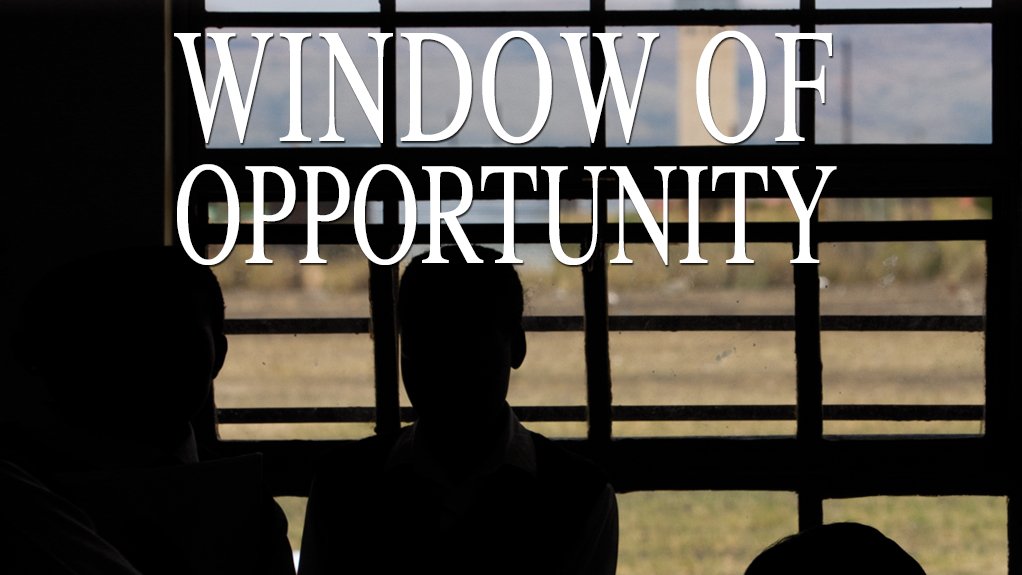Can revised strategy help bring young South Africans in from the economic cold?
As South Africa’s youth continue to be sidelined from the mainstream economy, government is moving to revive and refine its National Youth Policy (NYP) with the aspiration of unleashing the full potential of 41.2% of the population as “agents of change”, while correcting previous policy mistakes.
The 2015 to 2020 NYP proposes various interventions aimed at unclogging the critical blockages facing the country’s youth that, if left unchecked, could present a “serious threat” to social, political and economic stability. But civil society and business groupings believe that linking the policy to South Africa’s multibillion-rand infrastructure programme could prove to be the trump card.
The Department of Planning, Monitoring and Evaluation-led policy – a replacement for the now-lapsed National Youth Development Agency- (NYDA-) driven 2009 to 2014 NYP – aims to mobilise government and business to place youth development programmes at the centre of their strategies, says Deputy Minister in the Presidency Buti Manamela, who is spearheading the revamp.
The policy draws heavily on the National Development Plan and is informed by several government initiatives, including the Jobs Accord, the Industrial Policy Action Plan, the United Nations World Programme of Action for the Youth to the Year 2000 and Beyond and the African Youth Charter.
The NYP 2015–2020 identifies four priorities, namely enabling economic participation, facilitating quality and accessible skills development, reducing morbidity and mortality owing to risky behaviour and promoting social cohesion and nation building.
However, observers are calling for a more refined focus for the country’s limited resources towards education and employment as critical enablers to uplift the youth.
If government is able to redirect funding, focus and resources towards the education and unemployment challenges, it will go a long way towards easing the burdens of the other challenges facing youth and build on the aims of the policy, says Steel and Engineering Industries Federation of Southern Africa (Seifsa) skills development and human capital executive Mustak Ally.
“We need to start with the basics . . . focus on the root causes,” he explains, adding that attempting to do a “little of everything” results in only “pockets of success.”
The Key Lies in Employment
Creating job opportunities for young people is seen as key, with unemployment among youth aged 15 to 35 standing at 36.1%. By contrast, the unemployment rate for older South Africans stands at 15.6%. Youth make up 70% of the 25% unemployed citizens of working age, with about 60% of working-age young people under 35 having never experienced formal employment.
Similarly, the labour absorption rate of 57.8% for adults is nearly double the 30.8% rate for youths, which is arguably reflective of an economy that is growing well below potential.
For this reason, youth unemployment will need to be addressed in tandem with the national growth initiatives and by transforming the economy’s labour-absorbing potential.
“Many of the problems faced by the youth are faced by the rest of society,” says Consulting Engineers of South Africa (Cesa) acting CEO Wallace Mayne, adding that unemployment, poverty and inequality can be reduced – if not halved – by increasing infrastructure development.
Young Communist League of South Africa (YCLSA) spokesperson Khaya Xaba says the development of low-end skills and sustainable youth jobs should be driven in the same way as the Presidential Infrastructure Coordinating Commission and Industrial Policy Action Plan.
South Africa currently faces a lack of skills, owing to an uneven education system and education being placed second to other socioeconomic issues, and a lack of training, owing to uneven performance by both the private and public sectors when it comes to infrastructure investment and implementation.
“In order to train, the county needs to build a vibrant construction industry by supplying projects. With work, firms will be able to adequately cater for their own employees and provide training for the youth,” says Mayne.
While the policy does a “perfect job” of analysing the youth dilemma and identifying their key challenges, education and skills should be the top priority of the policy, as educated youth will be able to meaningfully participate in the economy.
The policy’s measures to enhance youth employment include industrial policy interventions to improve labour absorption and raising labour demand in the economy; skills development and training to prepare youth for jobs and enhance career mobility; work exposure measures to provide the youth with an opportunity to gain on-the-job experience and linking job seekers to employers; and interventions to enable financial, market access and business skills support systems for youth-owned companies and cooperatives.
However, Democratic Alliance shadow Deputy Minister for the Presidency Michael Cardo says that the policy is “woefully thin” on workable solutions, with vague interventions and a lack of firm implementation plans and details for job creation and economic inclusion.
“The NYP completely misses the boat on job creation for the youth. Instead of tinkering at the edges, it should put forward bold proposals on how to ramp up the youth wage subsidy, deregulate the labour markets to make it easier for youth to find jobs, ease the burden of labour regulations in the small business sector, enhance temporary work and create incentives for the private sector to take on first-time employees and get more involved in training.”
Education & Skills
Education was also a key factor highlighted by stakeholders, as South Africa needs a skilled workforce to thrust the country onto a higher developmental trajectory.
However, only 65% of the one-million students exiting school each year obtain a Grade 12 certificate, while fewer than 4.3% of those aged 18 to 29 are enrolled at a higher education institution in the country.
“We have to capture the majority,” Telecommunications and Postal Services Deputy Minister Hlengiwe Mkhize says, pointing out that only a handful obtain the scores necessary to enter university.
This is where colleges and further education institutions can play a critical role.
The technical and vocational education and training (TVET) sector should cater for about 25% – an increase from 300 000 to one-million by 2030 – of the age-relevant cohort, the policy notes.
Xaba says there is a need to strengthen work in education and skills development through existing technical and vocational education and training institutions and the sector education and training authorities, and the reopening of colleges of education, nursing and agriculture.
Further, the NYP notes that “special attention” needs to be given to opportunities that provide unskilled and uneducated youth with “second chance” opportunities.
“Community colleges have been designed to cater for youth who neither completed their schooling nor attended school and, as a result, do not qualify to study at TVET colleges and universities.”
The policy also points to developing linkages between the colleges, the Expanded Public Works Programme and the Community Works Programme.
In addition, there is a lot that must be done for the creation of a nonracial society.
Fewer than 4.3% of the 18- to 29-year-olds enrolled at a higher education institution in the country are African, compared with 18.7% of whites and 9.2% of Indians and Asians.
Further, only 1% of African schools are top performers in terms of high school results, compared with 31% of the formerly privileged schools.
Meanwhile, the policy points to six leading natural causes of death for those aged 15 to 34 in 2013, including tuberculosis, which accounted for 14% of all deaths in this age group, HIV/Aids at 10% and other viral diseases at 6%.
The policy says that a number of the diseases affecting youth today are associated with HIV, which indicates risky sexual behaviour.
Further, of the total number of deaths owing to assault and intentional self-harm, 69% and 59% respectively occur among those aged 15 to 34 years, while substance abuse remains a significant challenge for youth.
Comments
Press Office
Announcements
What's On
Subscribe to improve your user experience...
Option 1 (equivalent of R125 a month):
Receive a weekly copy of Creamer Media's Engineering News & Mining Weekly magazine
(print copy for those in South Africa and e-magazine for those outside of South Africa)
Receive daily email newsletters
Access to full search results
Access archive of magazine back copies
Access to Projects in Progress
Access to ONE Research Report of your choice in PDF format
Option 2 (equivalent of R375 a month):
All benefits from Option 1
PLUS
Access to Creamer Media's Research Channel Africa for ALL Research Reports, in PDF format, on various industrial and mining sectors
including Electricity; Water; Energy Transition; Hydrogen; Roads, Rail and Ports; Coal; Gold; Platinum; Battery Metals; etc.
Already a subscriber?
Forgotten your password?
Receive weekly copy of Creamer Media's Engineering News & Mining Weekly magazine (print copy for those in South Africa and e-magazine for those outside of South Africa)
➕
Recieve daily email newsletters
➕
Access to full search results
➕
Access archive of magazine back copies
➕
Access to Projects in Progress
➕
Access to ONE Research Report of your choice in PDF format
RESEARCH CHANNEL AFRICA
R4500 (equivalent of R375 a month)
SUBSCRIBEAll benefits from Option 1
➕
Access to Creamer Media's Research Channel Africa for ALL Research Reports on various industrial and mining sectors, in PDF format, including on:
Electricity
➕
Water
➕
Energy Transition
➕
Hydrogen
➕
Roads, Rail and Ports
➕
Coal
➕
Gold
➕
Platinum
➕
Battery Metals
➕
etc.
Receive all benefits from Option 1 or Option 2 delivered to numerous people at your company
➕
Multiple User names and Passwords for simultaneous log-ins
➕
Intranet integration access to all in your organisation




















